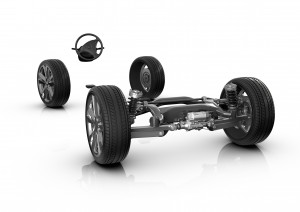- Active Kinematics Control (AKC): Toe angle modifications at the rear axle assist steering angle of passenger cars
- Increased driving dynamics and safety
- Integration with other active systems possible
- Electric actuators make the system energy-efficient
Steerable rear axles, which assist the steering angle of the front axle, have been on the automotive industry’s agenda for many years. This technology can improve driving safety as well as driving dynamics. Until now, it was too expensive, too complicated or too fuel-inefficient to implement. Meanwhile, ZF has a system that is ready for volume production, which facilitates steering movements of the rear axle by modifying the toe angle. The AKC system demonstrates its advantages as a standard active rear axle steering in Porsche’s 911 Turbo and 911 GT3 models.
 Track adjustment is an important task when developing the suspension. The overriding aim is to promote optimum vehicle handling because the toe angle on the chassis is responsible, among other things, for directional stability when braking and for the steering precision perceived by the driver. Suspension components such as toe links and control arms ensure that the track setting defined during chassis development on a volume production vehicle is maintained precisely.
Track adjustment is an important task when developing the suspension. The overriding aim is to promote optimum vehicle handling because the toe angle on the chassis is responsible, among other things, for directional stability when braking and for the steering precision perceived by the driver. Suspension components such as toe links and control arms ensure that the track setting defined during chassis development on a volume production vehicle is maintained precisely.
As soon as the track for a vehicle is defined, it cannot be varied anymore – and right at this point ZF chassis engineers came in. They tested how dynamically adjusting the track affects vehicle handling while on the move. To this end they developed a length-adjustable toe link, which lies at the center of the active system: Electromechanical actuators can vary the toe angle while the vehicle is moving; control software integrated into the vehicle electronics issues the commands. One advantage: A steering movement is produced by modifying the track angle. This is actually small (about three degrees) compared with the front axle, but steering intervention at the rear axle has a greater impact. Interacting with the steering angle of the front wheels, the result is a distinctly noticeable and positive impact on vehicle handling. This is the principle that underpins AKC. Depending on requirements and available installation space, the AKC system, which operates energy-efficiently according to the power-on-demand principle, is available in two variants: with an actuator in the center of the rear axle, also called a “central actuator” system, or with one actuator per rear wheel in Porsche’s 911 Turbo and 911 GT models.
“The technology delivers benefits in virtually every driving situation,” said Dr. Peter Holdmann, head of development at ZF’s Chassis Technology division and in charge of the Chassis Systems business unit. “If you are driving slowly through narrow streets, it steers contrary to the front wheels’ steering angle and generates a higher yaw rate of the vehicle.” The turning circle is then reduced by up to 10 percent, thus making passenger cars easier to maneuver. “At higher speeds, in other words from around 60 km/h, the system steers the rear wheels in the same direction as the front wheels, thus improving directional stability and driving dynamics,” Holdmann stated.
Steering assistance with AKC is created by electromechanical actuators which are not mechanically connected to the steering wheel. It is therefore a pure ‘by-wire’ system. This has the advantage that AKC can be integrated into the active control network of the particular passenger car. Then it assists the functions provided by other active systems – such as in combination with ESP. If you network AKC and the antilock braking system, stabilizing interventions of the brakes and rear axle improve the vehicle’s handling during deceleration. Thus the system enhances safety and driving dynamics at the same time. When braking on surfaces with varying grip, the stopping distance is reduced.













Homepage
… [Trackback]
[…] Informations on that Topic: autocomponentsindia.com/zf-active-kinematics-control-steering-impulses-from-the-rear-axle/ […]